The Best Sounding M3 in Michigan
Love it or hate, the E46 M3 BMW comes with a very distinctive mechanical sound straight from the factory. The so-called “rasp” actually comes from the engine and not the exhaust as so many people think. Nonetheless there are all sorts of exhaust “rasp eliminators” on the market today with a few actually doing a pretty good job of muffling the distinctive S54 engine note. But none of them add to the performance of the car.
At VRPerformance, we’re more interested in objective matters-- things that make the car perform better. So when we analyze an exhaust system, we’re looking at better flow with just the right amount of back pressure, the exhaust note is a by-product.
The OEM headers are surprisingly restrictive (bulges are the primary cats)
When we’re lucky, a system improves the objective of increased performance and the subjective sound of the exhaust. And that’s exactly what we have in this case study.
We installed a complete Supersprint exhaust system, front to rear, including long tube stepped headers, race catalytic converters, mid-pipe, and race mufflers. Along with an aFe cold air intake and updated software, we’re looking at a 10% increase in power output—which, on a normally aspirated engine that is already in such a high state of tune from BMW, is excellent.
Supesprint headers and race cats
Two sets of pre and post cat O2 sensors-- with some tricky re-routing, some of the cables can be re-used without splicing. We had to lengthen one set.
Nice tight fit, but it works.
Here you can see two things: one, how poorly separate components can fit sometimes (requiring a bit of "tweaking") and two, the density of the race cat honeycomb.
A nice view of the completed system.
Installing a complete exhaust system like this is next to impossible without a lift and a good set of tools. As is typical with aftermarket kits, some cutting, bending, shaving and general tweaking is required. But for most enthusiasts, the end result is worth the time and cost.
New Video:
